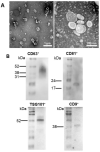Early Effects of Extracellular Vesicles Secreted by Adipose Tissue Mesenchymal Cells in Renal Ischemia Followed by Reperfusion: Mechanisms Rely on a Decrease in Mitochondrial Anion Superoxide Production
- PMID: 35328327
- PMCID: PMC8955255
- DOI: 10.3390/ijms23062906
Early Effects of Extracellular Vesicles Secreted by Adipose Tissue Mesenchymal Cells in Renal Ischemia Followed by Reperfusion: Mechanisms Rely on a Decrease in Mitochondrial Anion Superoxide Production
Abstract
Acute kidney injury (AKI) caused by ischemia followed by reperfusion (I/R) is characterized by intense anion superoxide (O2•-) production and oxidative damage. We investigated whether extracellular vesicles secreted by adipose tissue mesenchymal cells (EVs) administered during reperfusion can suppress the exacerbated mitochondrial O2•- formation after I/R. We used Wistar rats subjected to bilateral renal arterial clamping (30 min) followed by 24 h of reperfusion. The animals received EVs (I/R + EVs group) or saline (I/R group) in the kidney subcapsular space. The third group consisted of false-operated rats (SHAM). Mitochondria were isolated from proximal tubule cells and used immediately. Amplex Red™ was used to measure mitochondrial O2•- formation and MitoTracker™ Orange to evaluate inner mitochondrial membrane potential (Δψ). In vitro studies were carried out on human renal proximal tubular cells (HK-2) co-cultured or not with EVs under hypoxic conditions. Administration of EVs restored O2•- formation to SHAM levels in all mitochondrial functional conditions. The gene expression of catalase and superoxide dismutase-1 remained unmodified; transcription of heme oxygenase-1 (HO-1) was upregulated. The co-cultures of HK-2 cells with EVs revealed an intense decrease in apoptosis. We conclude that the mechanisms by which EVs favor long-term recovery of renal structures and functions after I/R rely on a decrease of mitochondrial O2•- formation with the aid of the upregulated antioxidant HO-1/Nuclear factor erythroid 2-related factor 2 system, thus opening new vistas for the treatment of AKI.
Keywords: acellular therapy; anion superoxide; extracellular vesicles; mesenchymal cells; mitochondria; proximal tubular cells; regenerative medicine; renal ischemia/reperfusion.
Conflict of interest statement
The authors declare that the research was conducted in the absence of any commercial or financial relationships that could represent potential conflicts of interest.
Figures









References
MeSH terms
Substances
Grants and funding
- E-26/202.963/2017/Carlos Chagas Filho Rio de Janeiro Research State Foundation/FAPERJ
- E-26/200.866/2021/Carlos Chagas Filho Rio de Janeiro Research State Foundation/FAPERJ
- E-26/202.312/2021/Carlos Chagas Filho Rio de Janeiro Research State Foundation/FAPERJ
- 465656/2014-5/National Institute of Science and Technology for Regenerative Medicine/REGENERA
- 311578/2019-5/Brazilian National Research Council/CNPq

